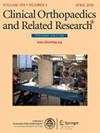Younger Age Is a Risk Factor for Discontinuing Military Service After THA.
IF 4.4
2区 医学
Q1 ORTHOPEDICS
引用次数: 0
Abstract
BACKGROUND With improved implant survival, THA is becoming more common in younger patients. Despite similar patient-reported outcomes between younger and older cohorts, it remains unclear whether age at THA may limit a patient's ability to return to their job. Evaluation of the return-to-duty rate in military personnel after THA may shed light on the potential functional status of civilian patients who are of a similar demographic in physically demanding professions. QUESTIONS/PURPOSES (1) What proportion of active-duty military personnel return to duty after THA? (2) What demographic and surgical factors were associated with this return-to-duty proportion? METHODS We performed a retrospective chart audit of all active-duty US military personnel who underwent primary THA between 2017 and 2020 at US military hospitals globally. A total of 452 patients underwent primary THA during the study period. Twenty-one percent (93 of 452) of patients with medical records lacking critical information for the primary analysis were excluded, leaving 79% (358) eligible for analysis. Most patients were men (85% [306 of 358]), and the median (range) age was 46 years (22 to 65). Approaches included direct anterior (58% [206]), posterior (40% [143]), and lateral (3% [9]). The most common indications were primary osteoarthritis (63% [226]), avascular necrosis (18% [64]), and secondary osteoarthritis attributed to dysplasia (15% [52]). Univariate analyses considered demographic and operative variables. Multivariable logistic regression analysis was utilized to assess independent factors for return to duty versus medical separation. RESULTS Ten percent (35 of 358) of patients underwent medical separation from service because of their hip after THA, with the remaining 90% returning to duty. After controlling for potentially confounding variables such as surgical approach, complications, and BMI, we found that decreasing age was associated with higher risk of medical separation, such that each year of increasing age was associated with a decreased risk of medical separation by 17% (OR 0.83 [95% CI 0.76 to 0.90]; p < 0.01). Patients serving in the US Navy were less likely to undergo separation from service than patients in the Army (OR 0.19 [95% CI 0.04 to 0.87]; p = 0.03). Complications and surgical approach were not found to be associated with increased odds of separation. CONCLUSION When treating active-duty military patients who qualify for THA, one must consider the occupation and age implications that surgical intervention may have on the patient. Analysis of this unique patient population may allow for improved understanding of outcomes in the growing number of young active civilian patients who undergo THA. These data can potentially be applied to that population, especially those in physically demanding jobs that may be analogous to military duty. The results of this study would also be of use when providing an evidence-based preoperative risk assessment for these patients regarding their postoperative functional outcomes. LEVEL OF EVIDENCE Level III, therapeutic study.年龄较低是髋关节置换术后停止服兵役的危险因素。
背景:随着种植体存活率的提高,THA在年轻患者中越来越普遍。尽管年轻和年长的患者报告的结果相似,但尚不清楚THA年龄是否会限制患者重返工作岗位的能力。对军人髋关节置换术后复职率的评估,可能有助于了解在体力要求较高的职业中,具有相似人口统计特征的平民患者的潜在功能状况。(2)哪些人口统计学和外科因素与复职比例相关?方法:我们对2017年至2020年在全球美军医院接受初级THA治疗的所有现役美军人员进行了回顾性图表审计。在研究期间,共有452例患者接受了原发性THA。21%(452名患者中的93名)的医疗记录缺乏主要分析的关键信息被排除在外,剩下79%(358名)符合分析条件。大多数患者为男性(85%[306 / 358]),中位年龄(范围)为46岁(22 - 65岁)。入路包括直接前路(58%[206])、后路(40%[143])和侧路(3% b[9])。最常见的适应症是原发性骨关节炎(63%[226])、缺血性坏死(18%[64])和继发性骨关节炎(15%[52])。单变量分析考虑了人口统计学和操作变量。采用多变量logistic回归分析评估复职与医疗离职的独立因素。结果358例患者中有35例(90%)因髋关节置换术后的原因而离职,其余90%返回工作岗位。在控制了手术入路、并发症和BMI等潜在的混杂变量后,我们发现年龄的降低与医学分离的风险增加相关,例如年龄的每增加一年与医学分离的风险降低17%相关(OR 0.83 [95% CI 0.76至0.90];P < 0.01)。在美国海军服役的患者比在陆军服役的患者更不容易离职(OR 0.19 [95% CI 0.04至0.87];P = 0.03)。未发现并发症和手术入路与分离几率增加有关。结论在治疗符合全髋关节置换术条件的现役军人患者时,必须考虑手术干预可能对患者的职业和年龄影响。对这一独特患者群体的分析可能有助于更好地了解越来越多接受THA的年轻活跃平民患者的预后。这些数据可以潜在地应用于这些人群,特别是那些从事类似于军事任务的体力要求高的工作的人。本研究的结果也可用于为这些患者的术后功能结局提供基于证据的术前风险评估。证据等级:III级,治疗性研究。
本文章由计算机程序翻译,如有差异,请以英文原文为准。
求助全文
约1分钟内获得全文
求助全文
来源期刊
CiteScore
7.00
自引率
11.90%
发文量
722
审稿时长
2.5 months
期刊介绍:
Clinical Orthopaedics and Related Research® is a leading peer-reviewed journal devoted to the dissemination of new and important orthopaedic knowledge.
CORR® brings readers the latest clinical and basic research, along with columns, commentaries, and interviews with authors.

 求助内容:
求助内容: 应助结果提醒方式:
应助结果提醒方式:


